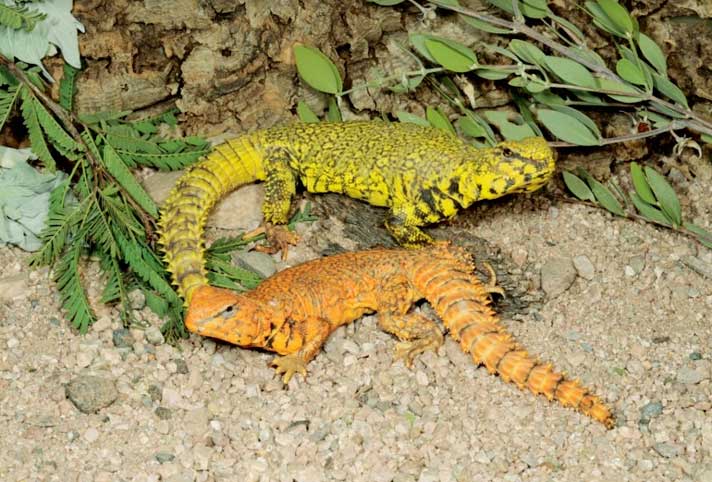The dabb lizards, as uromastyx are also known, may be on the cusp of massive popularity in the pet trade.
Question: Which kind of Uromastyx lizard is the most colorful? Are they easy to keep?
Andrew Cotreros, Pleasant Valley, Missouri
Answer: The genus Uromastyx is one of those up-and-coming groups of herps that haven’t yet made their big splash on the herpetocultural scene. That’s not to say they haven’t been embraced by a dedicated faction of keepers and breeders, but they haven’t gone “beardal” (that’s my newly coined word for the herp world, equivalent of something going viral).

Bill Love
Two exceptional male Uromastyx geryi of two color variants. Not all specimens look as vibrant as these.
I believe the dabb lizards, as uromastyx are also known, may be on the cusp of massive popularity in the pet trade, and the irregular influx of new species and new, colorful variations of “old” species, may be the trigger to launch them full-blown over the next decade. Why, you may ask? Let’s look at the attributes of the group.
Most uromastyx lizards fall into that comfort zone of perfect-sized pets, much like bearded dragons. The big boy of the bunch, the Egyptian (U. aegyptia), gets a little too large for some people, and is also the most drab in appearance. The other types, though, are “just the right size” and exhibit a range of colors that dazzle; two factors that will boost their popularity.
Read More
Ornate Uromastyx Care and Breeding Tips
Large Scale Uromastyx Hunting Condemned in Saudi Arabia
Also, the standard uromastyx diet is “refrigerator friendly.” These lizards should be fed on a daily basis, and the seeds (yes, seeds) and greens that make up the bulk of their diet can easily be kept in any home, unlike “messy” live rodents, crickets or other bugs that some people prefer not to deal with. Packets of a day’s worth of food can be prepped in advance and given to the lizards quickly and easily.
They need to be kept dry. Wild dabbs seldom, if ever, experience rain, and virtually never encounter standing water. So keeping a water bowl in their enclosures is unnecessary as long as they get enough moisture via their food.
In regard to your question about color: The most beautiful specimens that I’ve seen recently are adult Saharan (U. geyri) males from the north-central African countries of Niger, Algeria, and Mali. Most individuals are tan, but the biggest, dominant males occur in two main color phases: yellow and red-orange. This species gets along with minimal fighting in colony situations, too, and the same cannot be said of all Uromastyx. Do your homework and research other types before setting them up as groups.
Saharans, like all uromastyx, look their best when heated up. Keepers should provide a basking lamp that creates a hot spot of 100 or more degrees Fahrenheit. The lizards will move out from under the lamp when they’re warm enough, so use one that will be too hot (like the sun) for them to lay under all day long.
My other contender in regard to beauty is the ornate uromastyx (U. ornatus), which again is best represented by a big male in its full splendor of color. This species has been around for a decade or more, and captive-bred offspring can be found for sale sporadically. If you get a male, don’t worry if your new acquisition doesn’t look like the prettiest photos or ornates that you’ve seen. They take a couple years or more to attain their beautiful mature blue-green coloration.


